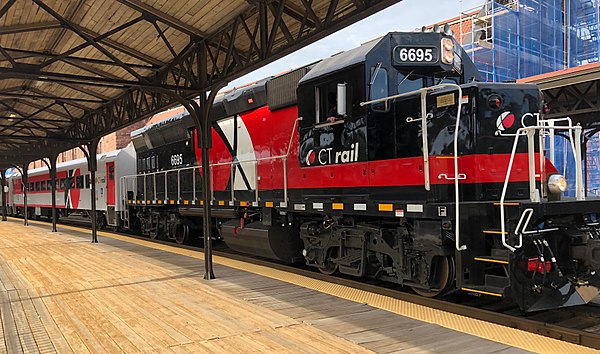Chris Powell: Overlook subsidy and new rail line looks lovely
A Hartford Line train at the Hartford Station
Wonderful as it is now to be able to take the train from Springfield to Hartford to New Haven and back as many as 16 times a day on the Hartford Line, Connecticut Gov . Ned Lamont and other state officials should have been far more realistic this week as they celebrated the railroad's first year of operation.
They noted that ridership has been greater than forecast, the trains are usually on time, passengers are happy, and the service is encouraging commercial and housing development along the line. Connecting with the Metro-North commuter rail system in New Haven, the Hartford Line gives the whole Connecticut Valley up to the Springfield area much more convenient access to New York, eliminating the need to drive a car into the city. This will increase the region's quality of life generally.
What the governor and his colleagues overlooked is the Hartford Line's enormous cost, and not just the infrastructure expense of restoring the double tracking and the stations along the line, estimated at $769 million in state and federal capital. Right or wrong, that money is already spent. Of greater concern is the railroad's operating expense, which the state Transportation Department reports at $43.9 million annually. Passenger fares are low, $13 or less one way, and the department says they have produced only $7.2 million on an annual basis, leaving a $36.7 million shortfall to be covered every year by state government.
Divided by the first year's 634,000 passengers, the Hartford Line is enjoying a taxpayer subsidy of nearly $59 per trip.
A bus ticket between any of the railroad's three main cities costs less than a third as much as the railroad's total cost for a passenger, and in some circumstances even a taxi's cost is less.
Travel by train is usually more pleasant and reliable than travel by buses and taxis, since the train avoids traffic congestion. But for those who want to work as they travel, long-distance buses typically have wireless internet service, while the Hartford Line doesn't.
So evaluating the Hartford Line requires evaluating not just the fun and novelty of the journey but, much more so, the taxpayer subsidy. Of course all transportation is subsidized by taxpayers, since the government builds and maintains the highways and airports and operates the air-traffic control system, not just passenger railroads. Further, in densely populated areas, like Connecticut's shoreline from New Haven to New York, without the railroad, which is overwhelmingly used by commuters, the highways would be impossibly crowded. Indeed, they often are already.
While $59 in state subsidy per ride may be justified to draw interest to the Hartford Line at the outset, for the long term it will be appalling. Growth in ridership may reduce the subsidy slightly, and the imposition of tolls on Interstate 91 may boost ridership. The Hartford Line's fares should be raised soon. But at best the line will be the longest of long-term infrastructure investments for Connecticut.
With its tens of billions of dollars of unfunded long-term liabilities, can Connecticut really afford the Hartford Line, or any infrastructure improvements? Of course not. Indeed, the state can't afford those unfunded liabilities either, and now the Hartford Line itself is another one. Celebrating the railroad last week the governor and those who joined him showed mainly that they're not yet serious about Connecticut's ride to insolvency.
Chris Powell is a columnist for the Journal Inquirer, in Manchester, Conn.
ReplyReply allForward
